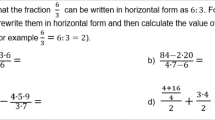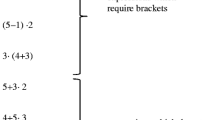Abstract
When a number sentence includes more than one operation, students are taught to follow the rules for the order of operations to get the correct result. In this context, brackets are used to determine the operations that should be calculated first. However, it seems that the written format of an arithmetical expression has an impact on the way students evaluate this expression. It also seems that a connection exists between this way of evaluation and an understanding of structure. Both issues are examined in this paper. A number of arithmetical expressions in a rational form were given to primary school students from Greece and Sweden. The collected findings strengthen our hypothesis that this rational form of the arithmetical expressions was of critical importance for the students’ decision on how to evaluate these expressions. They temporarily put aside their knowledge about the rules for the order of operations. Instead, the way they evaluated the expressions indicates an implicit use of what we call in this paper “mental” brackets. It is very likely that the use of these “mental” brackets is closely connected with students’ structure sense.








Similar content being viewed by others
References
Bannerjee, R., & Subramaniam, K. (2005). Developing procedure and structure sense of arithmetic expressions. In H. L. Chick & J. L. Vincent (Eds.), Proceedings of 29th Conference of the International Group for the Psychology of Mathematics Education (Vol. 2, pp. 121–128). Melbourne, Australia: PME.
Blando, J. A., Kelly, A. E., Schneider, B. R., & Sleeman, D. (1989). Analyzing and modeling arithmetic errors. Journal for Research in Mathematics Education, 20(3), 301–308.
Booth, L. R. (1988). Children’s difficulties in beginning algebra. In A. F. Coxford & A. P. Schulte (Eds.), The ideas of algebra, K-12 (1988 yearbook) (pp. 20–32). Reston, VA: National Council of Teachers of Mathematics.
Glidden, P. L. (2008). Prospective elementary teachers’ understanding of order of operations. School Science and Mathematics, 108(4), 130–136.
Gunnarsson, R., & Karlsson, A. (2015). Brackets and the structure sense. In O. Helenius, A. Engström, T. Meaney, P. Nilsson, E. Norén, J. Sayers & M. Österholm (Eds.), Proceedings of the 9th Swedish Mathematics Education Research Seminar (pp. 47–55). Umeå, Sweden: MADIF.
Gunnarsson, R., Sönnerhed, W. W., & Hernell, B. (2016). Does it help to use mathematically superfluous brackets when teaching the rules for the order of operations? Educational Studies in Mathematics, 92(1), 91–105.
Hewitt, D. (2005). Chinese whispers - algebra style: Grammatical, notational, mathematical and activity tensions. In H. L. Chick & J. L. Vincent (Eds.), Proceedings of the 29th Conference of the International Group for Psychology of Mathematics Education (Vol. 3, pp. 129–136). Melbourne: PME.
Hoch, M., & Dreyfus, T. (2004). Structure sense in high school algebra: The effect of brackets. In M. J. Høines & A. B. Fuglestad (Eds.), Proceedings of the 28th Conference of the International Group for the Psychology of Mathematics Education (Vol. 3, pp. 49–56). Bergen, Norway: PME.
Hoch, M., & Dreyfus, T. (2005). Students’ difficulties with applying a familiar formula in an unfamiliar context. In H. L. Chick & J. L. Vincent (Eds.), Proceedings of the 29th Conference of the International Group for the Psychology of Mathematics Education (Vol. 3, pp. 145–152). Melbourne, Australia: PME
Kieran, C. (1979). Children’s operational thinking within the context of bracketing and the order of operations. In D. Tall (Ed.), Proceedings of the 3rd Conference of the International Group for the Psychology of Mathematics Education (pp. 128–133). Warwick, UK: PME.
Kieran, C. (1988). Two different approaches among algebra learners. In A. F. Coxford (ed.). The Ideas of Algebra. K-12 (pp. 91–96). National Council of Teachers of Mathematics, Reston, VA; Lawence Erlbaum, Hillsdale, NJ,
Kieran, C. (1989). The early learning of algebra: A structural perspective. In S. Wagner & C. Kieran (Eds.), Research issues in the learning and teaching of algebra (vol. 4, pp. 33–56). Reston, VA: Lawrence Erlbaum Associates and National Council of Teacher of Mathematics.
Kirshner, D. (1989). The visual syntax of algebra. Journal for Research in Mathematics Education, 20(3), 274–287.
Landy, D., & Goldstone R. L. (2007). The alignment of ordering and space in arithmetic computation. In D. S. McNamara & J. G. Trafton (Eds.), Proceedings of the 29th Annual Conference of the Cognitive Science Society (pp. 437–442). Austin, TX: Cognitive Science Society.
Landy, D., & Goldstone, R. L. (2010). Proximity and precedende in arithmetic. The Quarterly Journal of Experimental Psychology, 63(10), 1953–1968.
Linchevski, L., & Herscovics, N. (1994). Cognitive obstacles in pre-algebra. In J. Matos (Ed.), Proceedings of the 18th conference of the International Group for the Psychology of Mathematics Education (Vol. 3, pp.176–183). Lisbon, Portugal: PME
Linchevski, L., & Livneh, D. (1999). Structure sense: The relationship between algebraic and numerical contexts. Educational Studies in Mathematics, 40(2), 173–196.
Linchevski, L., & Vinner, S. (1990). Embedded figures and structures of algebraic expressions. In G. Booker, P. Cobb, & T. N. Mendicuti (Eds.), Proceedings of the 14th Conference of the International Group for the Psychology of Mathematics Education (Vol. 2, pp. 85–93). Mexico City, Mexico: PME.
Marchini, C., & Papadopoulos, I. (2011). Are useless brackets useful for teaching? In B. Ubuz (Ed.), Proceedings of the 35th Conference of the International Group for the Psychology of Mathematics Education (Vol. 3, pp. 185–192). Ankara, Turkey: PME.
Mayring, P. (2014). Qualitative content analysis: Theoretical foundation, basic procedures and software solution. Klangenfurt, Germany: Beltz.
Papadopoulos, I., & Gunnarsson, R. (2018). The use of ‘mental’ brackets when calculating arithmetic expressions. In E. Bergqvist, M. Österholm, C. Granberg, & L. Sumpter (Eds.), Proceedings of the 42nd Conference of the International Group for the Psychology of Mathematics Education (Vol. 3, pp. 451–458). Umeå, Sweden: PME
Radford, L. (2000). Signs and meanings in students’ emergent algebraic thinking: A semiotic analysis. Educational Studies in Mathematics, 42(3), 237–268.
Siegler, R. S., Thompson, C. A., & Schneider, M. (2011). An integrated theory of whole number and fractions development. Cognitive Psychology, 62(4), 273–296.
Wu, H. (2007). “Order of operations” and other oddities in school mathematics. Retrieved from https://math.berkeley.edu/~wu/order5.pdf
Author information
Authors and Affiliations
Corresponding author
Additional information
Publisher’s note
Springer Nature remains neutral with regard to jurisdictional claims in published maps and institutional affiliations.
Rights and permissions
About this article
Cite this article
Papadopoulos, I., Gunnarsson, R. Exploring the way rational expressions trigger the use of “mental” brackets by primary school students. Educ Stud Math 103, 191–207 (2020). https://doi.org/10.1007/s10649-019-09929-z
Published:
Issue Date:
DOI: https://doi.org/10.1007/s10649-019-09929-z




